Keras
National Hazard
   
Posts: 766
Registered: 20-8-2018
Location: (48, 2)
Member Is Offline
|
|
Lithium metal from LiOH
Hello, hello —
I was wondering if the Mg method used to make potassium metal from KOH (reduction of KOH in petroleum oil with addition of small quantities of
tert-BuOH) would also work with LiOH. Just curious, if anyone has already attempted this.
|
|
|
Tsjerk
International Hazard
    
Posts: 3022
Registered: 20-4-2005
Location: Netherlands
Member Is Offline
Mood: Mood
|
|
I'm not an expert, some other people here are, but I believe it has something to do with density of potassium making this work for potassium and not
for sodium or lithium. Rubidium and cesium should work according to my knowledge, does anyone know of experiments done with Cs and Rb?
|
|
|
Keras
National Hazard
   
Posts: 766
Registered: 20-8-2018
Location: (48, 2)
Member Is Offline
|
|
Density?
I have stumbled on an article which states that electrolysis is the only method to produce lithium metal out of the hydroxide. But that doesn't mean
it is right.
|
|
|
draculic acid69
International Hazard
    
Posts: 1371
Registered: 2-8-2018
Member Is Offline
|
|
Nurdrage on YouTube recently answered this and so far it's a no.watch through the last two years of his videos if you want to understand more about
this process.2-3 videos ago he did the LiOH one.he hasn't got it to work yet but maybe it could be made to work somehow.idtry mg powder and LiOH under
an argon blanket or in a sealed vessel under vacuum (is the mg absorbing atmospheric O2 or is it grabbing the one from the hydroxide?too tired ATM to
think bout it) followed by running oil or dioxane straight on top of it then try and figure out how to purify it.
|
|
|
Tsjerk
International Hazard
    
Posts: 3022
Registered: 20-4-2005
Location: Netherlands
Member Is Offline
Mood: Mood
|
|
sodium and lithium float, and therefor oxidize, but yes, it might work under argon.
|
|
|
Keras
National Hazard
   
Posts: 766
Registered: 20-8-2018
Location: (48, 2)
Member Is Offline
|
|
Just saw the video. He doesn't say it doesn't work, he says it's impossibly slow. There might be a way to speed it up, if only by cranking up the
temperature maybe? Nerdrage's hot plate stops at 250 °C, maybe by increasing to 300/350 we could get better results?
|
|
|
Tsjerk
International Hazard
    
Posts: 3022
Registered: 20-4-2005
Location: Netherlands
Member Is Offline
Mood: Mood
|
|
Potassium tert-butoxide boils at 275, so you would push it out of the reaction even with a reflux condenser. But I don't see a necessity for
speeding things up, if it works in the first place.
I also didn't find references for lamp oil boiling above 275.
Edit: why do you need lithium if you can make potassium?
Edit2: I wasn't thinking... lithium tert-butoxide boils at 70 degrees.
[Edited on 25-5-2019 by Tsjerk]
|
|
|
Keras
National Hazard
   
Posts: 766
Registered: 20-8-2018
Location: (48, 2)
Member Is Offline
|
|
Well, lithium can be used to produce strong bases, yes. Also, there's a way to make lithium hydride and then LiAlH4 from that. But, well,
it's more the thrill of the challenge I suppose?
|
|
|
draculic acid69
International Hazard
    
Posts: 1371
Registered: 2-8-2018
Member Is Offline
|
|
I think nurdrage tried menthol instead of a tert alcohol which worked well for sodium but doesn't appear to work for K.i think because of the steric
hindrance of K's size affecting how it fits within the menthol.maybe bcoz of Lithium's small size it fits too well and doesn't have the steric
hindrance factor that Na has.might need to go back to long chain tert OH's or experiment with different alcohols all over again.or go with what
turbocharged the sodium rxn,using 1,8 cineole as solvent (faster rxn time) and borneol(fastest catalyst found) then maybe it will go to completion.or
maybe because lithium is so small by comparing it to sodium and K a primary alcohol might become an option again .or would just making sodium and
refluxing with lithium chloride work to make nacl & Lithium
[Edited on 27-5-2019 by draculic acid69]
|
|
|
Keras
National Hazard
   
Posts: 766
Registered: 20-8-2018
Location: (48, 2)
Member Is Offline
|
|
Ok, so I thought a bit about that and here it is.
1. Thermodynamically, reduction of LiOH, NaOH and KOH by Mg producing MgO according to 2XOH + 2Mg → 2X + 2MgO + H2 is possible because
the ∆Hf of MgO is really high (around -600 kJ/mol), whereas LiOH's, for example, is only -484 kJ/mol.
2. Still, there's no way the reaction can happen between two solids. So tert-butanol plays a central role. I think here,
tert-butanol somehow reacts with a few potassium atoms that maybe float around from the early start of the reaction to form potassium
tert-butoxide. Now potassium tert-butoxide is a strong base, stronger than KOH itself, so it can probably abstract a hydrogen atom
from KOH and form KO- or KO• or something. That KO then reacts with Mg to form MgO, K is liberated, and somehow H2 bubbles
out. potassium tert-butoxide is reformed and the reaction can proceed.
So I wonder if the key here is not to have a catalytic amount of a very strong base, so I'd try the reaction with lithium dropping minute quantities
of potassium tert-butoxide instead of a tertiary alcohol.
|
|
|
draculic acid69
International Hazard
    
Posts: 1371
Registered: 2-8-2018
Member Is Offline
|
|
K+mgcl2 in THF= Mg and kcl so does LiOH+K=kcl+Lithium. Lithium+ NaAlH4=lah and I think I read somewhere that it goes both ways Na+lah = lithium and
NaAlH4.
Point being can LiCl+k in THF =lithium and kcl.
|
|
|
Keras
National Hazard
   
Posts: 766
Registered: 20-8-2018
Location: (48, 2)
Member Is Offline
|
|
Quote: Originally posted by draculic acid69  | K+mgcl2 in THF= Mg and kcl so does LiOH+K=kcl+Lithium. Lithium+ NaAlH4=lah and I think I read somewhere that it goes both ways Na+lah = lithium and
NaAlH4.
Point being can LiCl+k in THF =lithium and kcl. |
What? LiOH + K → KOH + Li? Really?
I mean, I checked on NIST, and here it is:
LiOH (solid) ∆Hf = -484.9 kJ/mol; S = 42.81 J/mol/K
KOH (solid) ∆Hf = -424.7 kJ/mol; S = 78.9 J/mol/K
So, the overall reaction above has:
∆G = -424700 + 484900 - T (78.9 - 42.8)
∆G = 60200 - 36.1 T
which gives ∆G = 0 for T = 1667 K or 1400 °C circa.
Reaction web agrees more or less with this.
Also I saw a passing mention of LiOH + KCl → LiCl + KOH, but that is not thermodynamically possible either, except at very high temperatures.
[Edited on 28-5-2019 by Keras]
|
|
|
draculic acid69
International Hazard
    
Posts: 1371
Registered: 2-8-2018
Member Is Offline
|
|
Heat of formation,delta temp,joules, thermodynamics all boring shit I slept through in class.never bothered to learn it.least favourite part of
chemistry.
|
|
|
Keras
National Hazard
   
Posts: 766
Registered: 20-8-2018
Location: (48, 2)
Member Is Offline
|
|
Quote: Originally posted by draculic acid69  | | Heat of formation,delta temp,joules, thermodynamics all boring shit I slept through in class.never bothered to learn it.least favourite part of
chemistry. |
Well, it can at least save some time not spending hours trying to work out a reaction that has no chance to happen…
|
|
|
zed
International Hazard
    
Posts: 2277
Registered: 6-9-2008
Location: Great State of Jefferson, City of Portland
Member Is Offline
Mood: Semi-repentant Sith Lord
|
|
Hah!
The difficult we do immediately. The impossible may take slightly longer.
https://www.youtube.com/watch?v=Buq40brGDTY
|
|
|
draculic acid69
International Hazard
    
Posts: 1371
Registered: 2-8-2018
Member Is Offline
|
|
Quote: Originally posted by Keras  | Quote: Originally posted by draculic acid69  | | Heat of formation,delta temp,joules, thermodynamics all boring shit I slept through in class.never bothered to learn it.least favourite part of
chemistry. |
Well, it can at least save some time not spending hours trying to work out a reaction that has no chance to happen…
2 minutes to write a post and then waited for the answer.didnt take hrs of figuring out. |
|
|
|
elementcollector1
International Hazard
    
Posts: 2684
Registered: 28-12-2011
Location: The Known Universe
Member Is Offline
Mood: Molten
|
|
I believe this is most appropriately referred to as 'spoonfeeding.' It's not smiled upon in this forum.
Back on topic: There's undoubtedly some catalyst/solvent mix out there that can work for lithium. Pok's original work with caesium, rubidium and
potassium, Sciencemadness user replications and NurdRage's later experiments with sodium strongly indicate that a variety of factors can influence the
outcome, from solvent drying to magnesium supplier/form to catalyst addition method. Therefore, it's a little hard to say if something works or
doesn't work right off the bat - NurdRage even notes something similar in the video.
To use a personal anecdote, it took me 10 tries to get K using this method, each using a slightly different setup than the last. On attempt #8, I
noted that while I had gotten potassium, it only came as a few very tiny spheres among a pile of still-unreacted KOH and Mg. I later found that this
was due to catalyst freezing in the condenser above the flask, unable to react further with the mixture. While that doesn't quite carry over for
NurdRage's setup, the point is that such minute details can easily cause someone to think something isn't working very well, or is only working
slowly.
I would note that his use of mineral oil was something I discontinued around attempt #5, as it proved too unpredictable of a solvent for me to work
with. Kerosene proved to be a much better alternative. I also agree with his observation that alkali metals perform this reaction faster with
increasing 'reactivity' (there's a graph to be made there, to be honest, but it would probably place lithium firmly at the ass-end of an exponential
curve, requiring thousands of hours of heating to complete the reaction).
I'd also like to note a critical detail NurdRage may have overlooked (which may be partially responsible for low reaction rates): Work by Dan Vizine
on this forum on ampouling and containing Li revealed that it cannot be melted in a glass ampoule, due to immediately reacting with the glass. I think
what might be happening is that any Li that is being formed is immediately melting and hitting the glass walls, promptly turning into lithium
silicate. However, this is countered by his observation that the glass flask used for the molten LiOH/Mg mixture remained untouched at the end of the
trial runs, meaning no significant amount of Li had been produced to react with it in the first place. I wonder if switching container material would
result in an improvement?
Elements Collected:52/87
Latest Acquired: Cl
Next in Line: Nd
|
|
|
Keras
National Hazard
   
Posts: 766
Registered: 20-8-2018
Location: (48, 2)
Member Is Offline
|
|
Not exactly. I didn't want to embark on something which would have no chance of success, lose time and maybe also money in the reagents, especially if
others have tried it before and failed. Before trying to climb the Everest, it can be a good idea to discuss with people who have already attempted
the ascension, in order not to repeat the same errors or trip over the same pitfalls – learn from others' experience. Besides, I have only access to
my lab a couple of times a month, so I prefer discuss things here in advance just to optimise what I plan to carry out.
Quote: Originally posted by elementcollector1  | To use a personal anecdote, it took me 10 tries to get K using this method, each using a slightly different setup than the last. On attempt #8, I
noted that while I had gotten potassium, it only came as a few very tiny spheres among a pile of still-unreacted KOH and Mg. I later found that this
was due to catalyst freezing in the condenser above the flask, unable to react further with the mixture. While that doesn't quite carry over for
NurdRage's setup, the point is that such minute details can easily cause someone to think something isn't working very well, or is only working
slowly.
I would note that his use of mineral oil was something I discontinued around attempt #5, as it proved too unpredictable of a solvent for me to work
with. Kerosene proved to be a much better alternative. I also agree with his observation that alkali metals perform this reaction faster with
increasing 'reactivity' (there's a graph to be made there, to be honest, but it would probably place lithium firmly at the ass-end of an exponential
curve, requiring thousands of hours of heating to complete the reaction).
I'd also like to note a critical detail NurdRage may have overlooked (which may be partially responsible for low reaction rates): Work by Dan Vizine
on this forum on ampouling and containing Li revealed that it cannot be melted in a glass ampoule, due to immediately reacting with the glass. I think
what might be happening is that any Li that is being formed is immediately melting and hitting the glass walls, promptly turning into lithium
silicate. However, this is countered by his observation that the glass flask used for the molten LiOH/Mg mixture remained untouched at the end of the
trial runs, meaning no significant amount of Li had been produced to react with it in the first place. I wonder if switching container material would
result in an improvement? |
Well, thanks for sharing. The process used by NurdRage and also described in the book Small Scale Synthesis of Laboratory Reagents as well as
in the US patent application 4,725,311 mentions only sodium, potassium and heavier alkali metals, but not lithium.
If I try the experiment, I'll probably pick a TPX beaker. Seems to be inert to strong bases and alkali metals, and it can be pushed to 150 °C at
least.
[Edited on 5-6-2019 by Keras]
|
|
|
draculic acid69
International Hazard
    
Posts: 1371
Registered: 2-8-2018
Member Is Offline
|
|
2 minutes to write a post and then waited for the answer.didnt take hrs of figuring out.[/rquote]
I believe this is most appropriately referred to as 'spoonfeeding.' It's not smiled upon in this forum.[/rquote]
Not exactly. I didn't want to embark on something which would have no chance of success, lose time and maybe also money in the reagents, especially if
others have tried it before and failed.
Agreed,I wouldn't call asking one question spoon-feeding.im just not good with that area of chemistry. I don't think anyone would be too put out by
saying 'nope won't work'.
Keras do u have a cork stopper for the beaker you intend to use.remember it needs an airfree environment.i reckon beakers could be used with a cork
stopper with a hole drilled in it and ample teflon tape.you can buy 1-2inch wide teflon tape which would be perfect for wrapping cork stoppers.
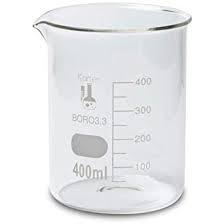 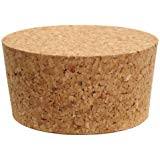 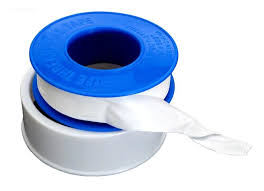 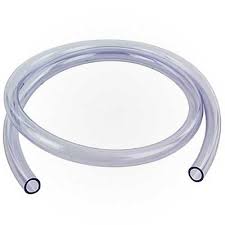
|
|
|
j_sum1
Administrator
       
Posts: 6218
Registered: 4-10-2014
Location: Unmoved
Member Is Offline
Mood: Organised
|
|
Whoa.
Small Scale Synthesis uses molten salt electrolysis at 315C.
Nurdrage uses catalysed reduction using magnesium.
They are not the same.
Edit
That comment was directed to Keras who mentioned SSS two posts up.
[Edited on 5-6-2019 by j_sum1]
|
|
|
Keras
National Hazard
   
Posts: 766
Registered: 20-8-2018
Location: (48, 2)
Member Is Offline
|
|
Quote: Originally posted by j_sum1  | Whoa.
Small Scale Synthesis uses molten salt electrolysis at 315C.
Nurdrage uses catalysed reduction using magnesium.
They are not the same.
[Edited on 5-6-2019 by j_sum1] |
Nah, look at the final section of the potassium chapter in the book (p.48, cf. attached screenshot)
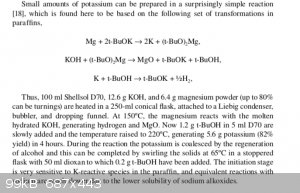
|
|
|
j_sum1
Administrator
       
Posts: 6218
Registered: 4-10-2014
Location: Unmoved
Member Is Offline
Mood: Organised
|
|
And I looked at the sodium chapter: it is what Nurdrage has been working on. My bad.
Extending the method to Li is I think problematic. Extending to Na has been a huge task. And there are more hurdles to overcome for lithium.
|
|
|
Keras
National Hazard
   
Posts: 766
Registered: 20-8-2018
Location: (48, 2)
Member Is Offline
|
|
Quote: Originally posted by j_sum1  | And I looked at the sodium chapter: it is what Nurdrage has been working on. My bad.
Extending the method to Li is I think problematic. Extending to Na has been a huge task. And there are more hurdles to overcome for lithium.
|
No worries 
Yeah, I would agree (that why I asked the question in the first place). Still, I wonder if mixing a small amount of KOH with LiOH to form t-BuK in
situ wouldn't jump-start the reaction? TBH, I am a bit at a loss. Might give it a go on a micro-scale, just to see what happens.
|
|
|
Keras
National Hazard
   
Posts: 766
Registered: 20-8-2018
Location: (48, 2)
Member Is Offline
|
|
Quote: Originally posted by draculic acid69  |
Keras do u have a cork stopper for the beaker you intend to use. Remember it needs an airfree environment. I reckon beakers could be used with a cork
stopper with a hole drilled in it and ample teflon tape. You can buy 1-2inch wide teflon tape which would be perfect for wrapping cork stoppers.
|
I have teflon tape I use to seal the vials that I put highly volatile liquids in such as diethyl-ether.
I don't remember K/Na isolation had to be carried out under inert atmosphere, though? Apparently you can produce lithium metal using molten LiCl/KCl
electrolysis at 400 °C in air, as the same book vouches (cf. attached screenshot), so that would make the other method pretty much feasible in air,
too, given the conditions are much milder.
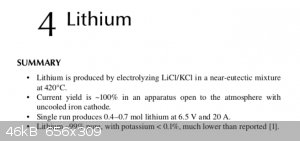
|
|
|
Fery
National Hazard
   
Posts: 990
Registered: 27-8-2019
Location: Czechoslovakia
Member Is Offline
|
|
here methods of industrial Li metal production, very likely not suitable for home chemistry, but interesting anyway
Attachment: zhang2020.pdf (1.2MB)
This file has been downloaded 241 times
|
|
|